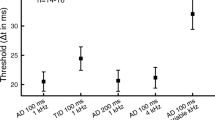Summary
This paper examines the reproduction of both regular rhythms and irregular sequences by 5- and 7-year-old children, concentrating on the important role played by their organization around a pulse train. It is shown that: (a) the closer rhythms are to a regular beat the easier they are to reproduce and the greater are the improvements with age; (b) memory capacity is limited by the number of pulses around which the rhythm is organized rather than by the number of elements it contains; (c) all the children's productions contain two interval lengths that are in a ratio close to 1:2 and arranged in preferential sequences which we have called “stereotypes”; (d) arrhythmic sequences can only be reproduced if the intervals undergo a systematic distortion towards regularity. These results are interpreted in relation to a pulse-train hypothesis which states that on hearing a rhythm an “internal clock” or “time base” is evoked around which the rhythm is structured.
Similar content being viewed by others
References
Benjamin, W. E. (1984). A theory of musical meter. Music Perception, 1, 355–413.
Cooper, G., & Meyer, L. B. (1960). The rhythmic structure of music. Chicago: University of Chicago Press.
Demany, L., McKenzie, B., & Vurpillot, E. (1977). Rhythm perception in early infancy. Nature, 266, 718–719
Dowling, W. J., & Harwood, D. (1986). Music cognition. New York: Academic Press.
Dowling, W. J. (1984). Developmental schemata in children's spontaneous singing. In W. R. Crozier & A. J. Chapman (Eds.), Cognitive processes in the perception of art. Amsterdam: North-Holland, 145–163.
Essens, P. J., & Povel, D. J. (1985). Metrical and nonmetrical representations of temporal patterns. Perception & Psychophysics, 37, 1–7.
Fraisse, P. (1956). Les structures rythmiques. Louvain: Éditions Universitaires.
Fraisse, P. (1974). Psychologie du rythme. Paris: PUF.
Fraisse, P. (1982). Rhythm and tempo. In D. Deutsch (Ed.), The psychology of music. New York: Academic Press, pp. 149–180.
Gérard, C. (1988a). L'enfant et le rythme: Étude expérimentale de la discrimination et de la reproduction de rhythmes musicaux. Vibrations, 6, 70–105.
Gérard, C. (1988b). Perception du temps et du rythme: L'enfant dispose-t-il d'une horloge interne? Marsyas, Revue de l'Institut de Pédagogie Musicale et Choréographie, 8, in press.
Gérard, C., & Auxiette, C. (1988). The role played by melodic and verbal organization in the reproduction of rhythmic groups by children. Music Perception, 6, 175–194.
Gérard, C., & Basso, C. (1987). Synchronisation sur les accents métriques, phénoménaux et structuraux d'un morceau musical chez les enfants de 5–6 ans. Master's dissertation, Paris V.
Gérard, C., Drake, C., & Auxiette, C. (1988). The role played by musical competence in the reproduction of rhythmic patterns by children. Submitted to Psychology of Music.
Gérard, C., & Roussel, I. (1987). Étude des stéréotypes rythmiques chez les enfants. Master's Dissertation, Paris V.
Handel, S. (1984). Using polyrhythms to study rhythms. Music Perception, 1, 465–484.
Hantz, E. (1984). Studies in musical cognition: Comments from a music theorist. Music Perception, 2, 245–264.
Hulse, S. H., Humpal, J., & Cynx, J. (1984). Discrimination and generalization of rhythmic and arrhythmic sound patterns by European Starling (Sturnus Vulgaris). Music Perception, 1, 442–464.
Lerdahl, F., & Jackendoff, R. (1983a). A generative theory of tonal music. Cambridge, Mass.: MIT Press.
Lerdahl, F., & Jackendoff, R. (1983b). An overview of hierarchical structure in music. Music Perception, 1, 229–252.
Monahan, C. B., & Carterette, E. C. (1985). Pitch and duration as determinants of musical space. Music Perception, 3, 1–32.
Narmour, E. (1983). Some major theoretical problems concerning the concept of hierarchy in the analysis of tonal music. Music Perception, 1, 129–199.
Povel, D. J. (1981). Internal representation of temporal patterns. Journal of Experimental Psychology: Human Perception and Performance, 7, 3–18.
Povel, D. J., & Essens, P. (1985). Perception of temporal patterns, Music Perception, 2, 411–440.
Serafine, M. L. (1979). A measure of meter conservation in music, based on Piaget's theory. Genetic Psychological Monographs, 99, 185–229.
Sloboda, J. A. (1985). The musical mind: The cognitive psychology of music. Oxford: Clarendon Press.
Swain, J. D. (1986). The need for limits in hierarchical theories of music. Music Perception, 4, 121–148.
Washburn, K. J., & Cohen, L. B. (1984). Infant perception of rhythmic form. Presented at the International Conference on Infant Studies, New York.
Zénatti, A. (1981). L'Enfant et son environment musical. Paris: PUF.
Author information
Authors and Affiliations
Rights and permissions
About this article
Cite this article
Drake, C., Gérard, C. A psychological pulse train: how young children use this cognitive framework to structure simple rhythms. Psychol Res 51, 16–22 (1989). https://doi.org/10.1007/BF00309271
Received:
Issue Date:
DOI: https://doi.org/10.1007/BF00309271




